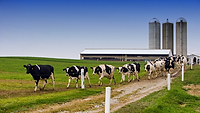FAO Encourages All Countries to Monitor for HPAI H5N1 Spread to Cattle

Image credit: jcomp via Freepik
In light of the global Highly Pathogenic Avian Influenza H5N1 (HPAI H5N1) outbreak, and considering the virus’ spread from poultry to dairy cows in North America, the Food and Agriculture Organization of the United Nations (FAO) has published recommendations for improving surveillance and detection measures for HPAI H5N1 in cattle.
The ongoing HPAI H5N1 outbreak has affected wild birds and poultry in nearly all regions around the world; however, all eyes are on North America, where, as of December 19, 2024, the virus has been reported in 865 dairy herds in 16 U.S. states. More than 123 million birds across the country and 61 humans, most of whom were exposed to sick cows, have been infected, as well. California has declared a state of emergency to enable more flexible outbreak response. The U.S. Department of Agriculture (USDA) has launched a National Milk Testing Strategy (NMTS) to monitor the virus in milk and dairy herds, and is also routinely testing dairy cows at slaughter for the presence of HPAI H5N1.
Although U.S. dairy herds are already being affected by HPAI H5N1 and the nation subsequently implemented a systematic approach to detecting and monitoring the virus, FAO is encouraging other countries to prepare their own surveillance systems to enhance early detection, so that authorities are ready to mitigate the impacts of spillover from birds to cattle and prevent transmission between cattle herds. FAO’s recently published recommendations also aim to assist low- and middle-income countries in optimizing the use of limited resources to achieve surveillance objectives by leveraging existing surveillance programs.
FAO recommends that all countries maintain passive surveillance for HPAI H5N1 to rapidly detect spread to non-avian species, as well as conducting education and outreach to relevant stakeholders to improve awareness of the emerging threat. Countries may also benefit from other surveillance approaches to leverage routine and opportunistic sampling to evaluate cattle health. Event-based surveillance may also be a helpful tool in early detection.
For at-risk countries, targeted or risk-based surveillance approaches can be used to more closely assess cattle health at the interface with poultry or wild birds, investigate suspected outbreaks in cattle, and demonstrate freedom from infection. At-risk countries are those that produce cattle, have not reported any cases of HPAI H5N1 in their cattle populations, and meet at least one of the following criteria: HPAI cases have been reported in wild birds or poultry, HPAI has been detected in non-avian species, and there is non-negligible likelihood of HPAI introduction and spillover to livestock.
The FAO recommendations also have a broad application to other susceptible farmed mammals.
Looking for a reprint of this article?
From high-res PDFs to custom plaques, order your copy today!






